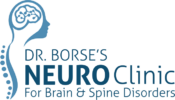PARALYSIS & STROKE

PARALYSIS
Experiencing paralysis entails the loss of muscle function in a specific body part, which may vary in severity, duration, and extent. While it can occur at any stage of life and affect any body part, pain sensation is typically absent. Seek guidance from the best neurologist near you, Dr. Sandeep Borse, for expert evaluation and personalized care.
A stroke, medically termed a cerebrovascular accident (CVA), occurs when a portion of the brain is deprived of blood supply, resulting in loss of function in the corresponding body part. This lack of blood flow can be due to ischemia or hemorrhage within the brain tissue. Recognized as a medical emergency, strokes pose risks of death or lasting disability. Treatment for ischemic strokes is most effective when initiated within the critical early hours following stroke onset.
Specific symptoms of a stroke are sudden facial deviation on one side, arm or leg weakness, imbalance, double vision, headache, and vomiting.
Patients should reach the hospital in 4.5 hours, which is a golden hour so that doctors can give a clot-buster injection called tPA (tissue plasminogen activator) and dissolve the clot-blocking artery so that patient recovery is faster.
The clot can be removed from the artery by advanced technology called mechanical thrombectomy by an interventional neurologist when the patient reaches the hospital within 6 hours of stroke symptoms onset.
Other treatments included blood thinner medicines, BP control, and physiotherapy.
